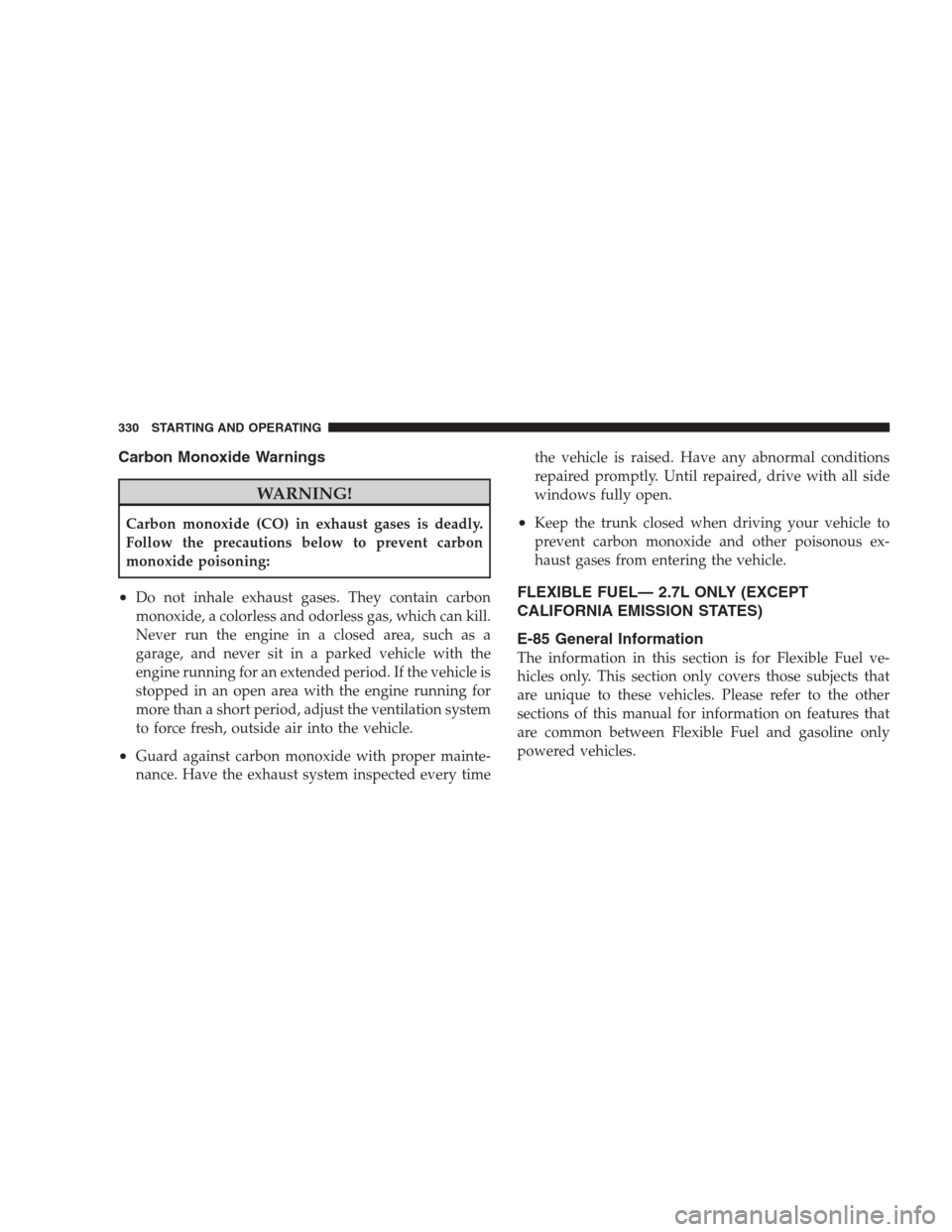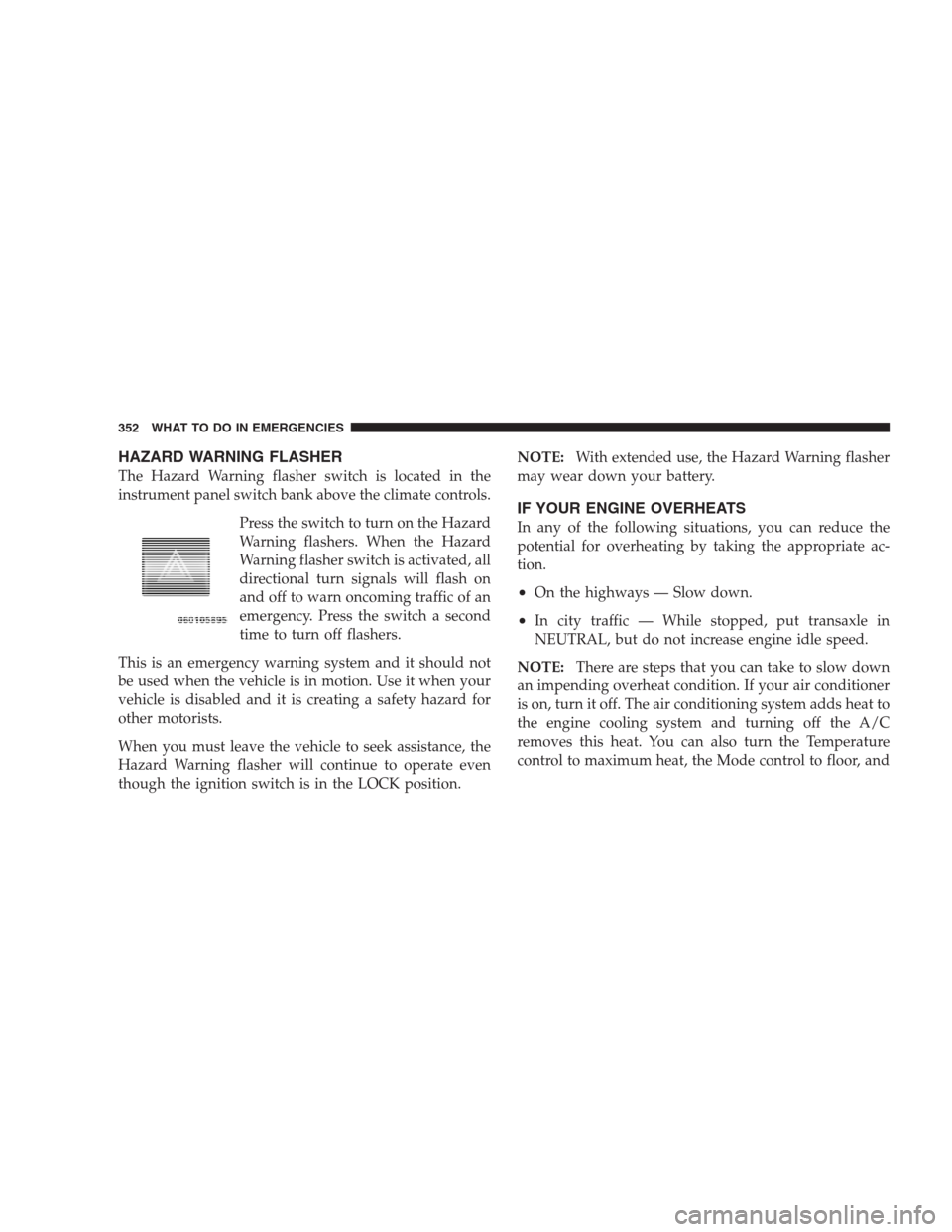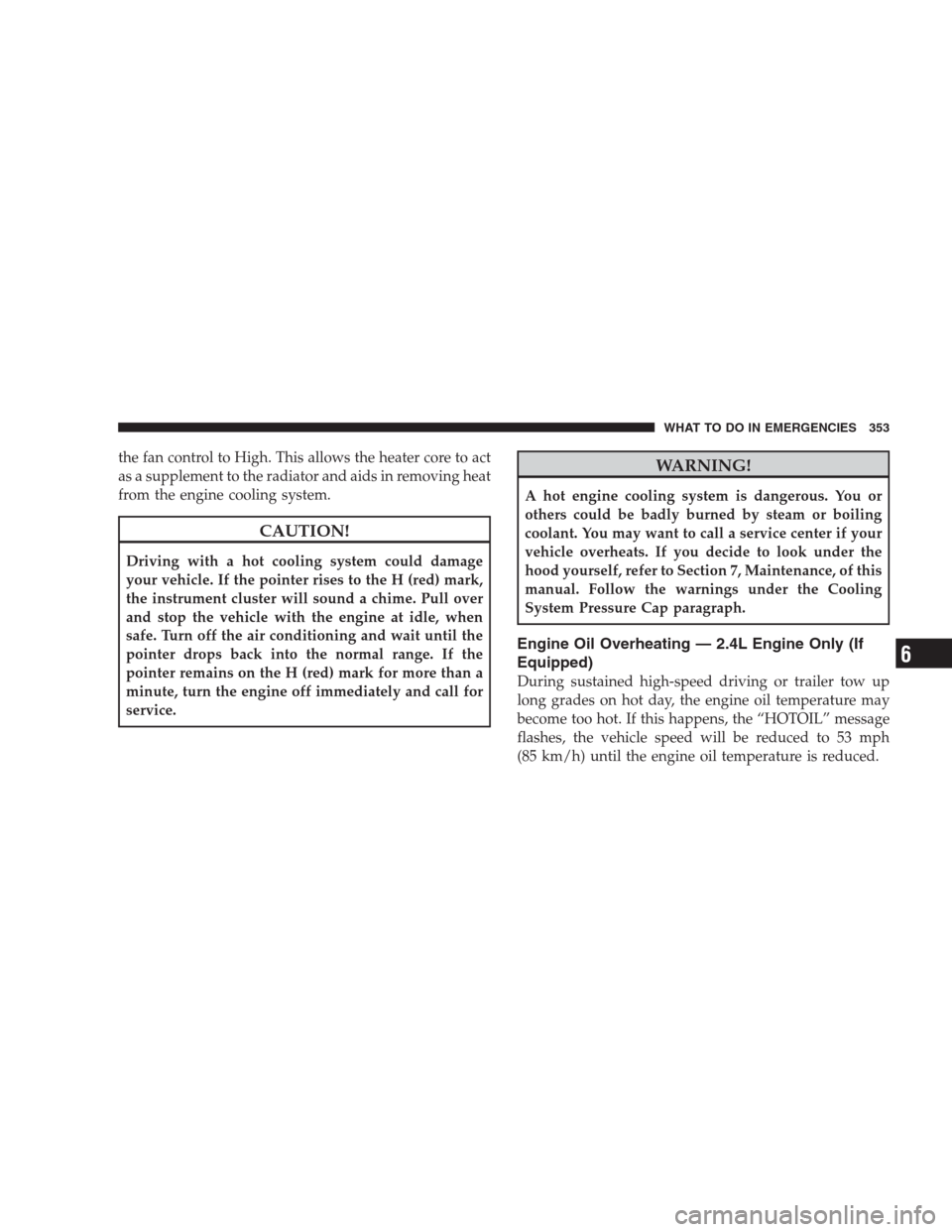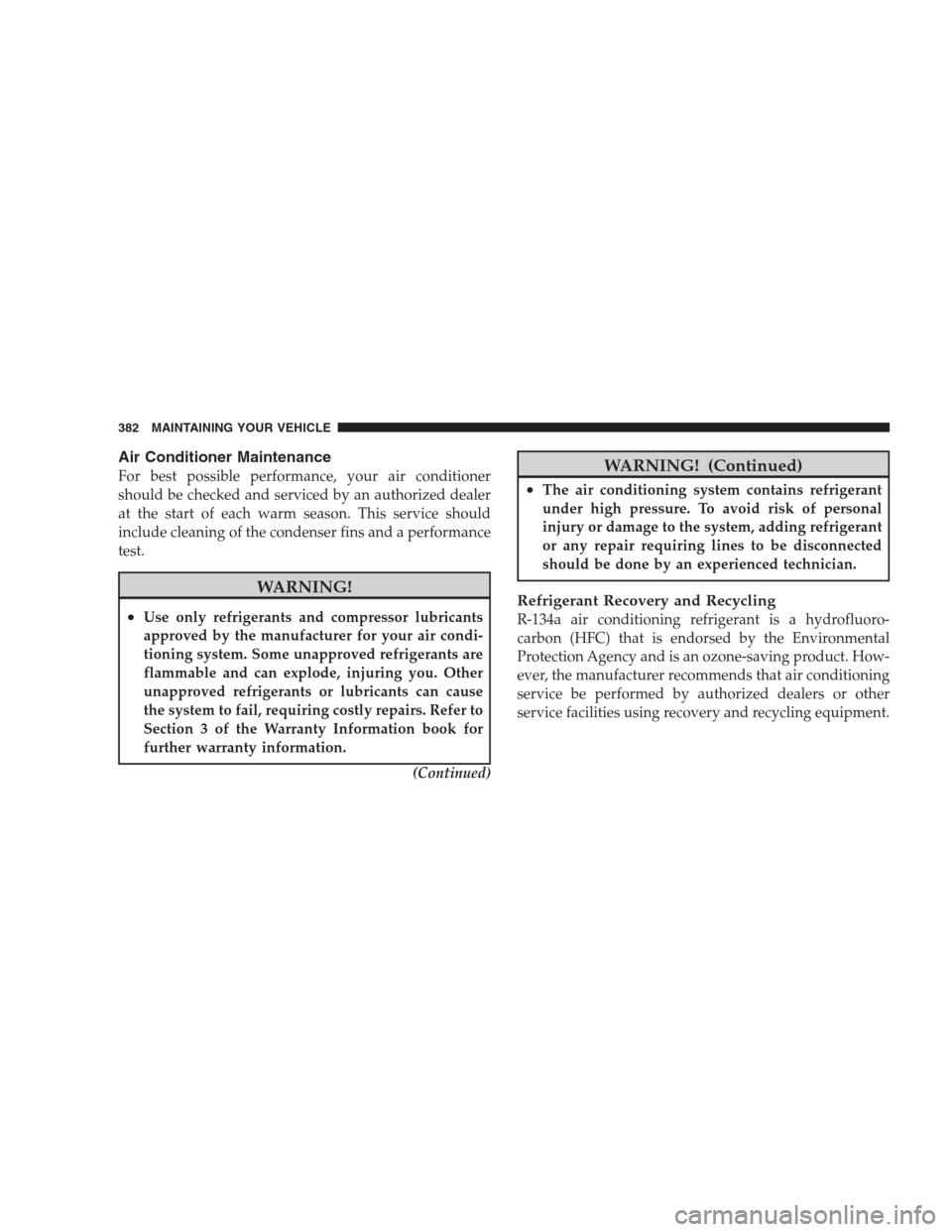Page 332 of 475

Carbon Monoxide Warnings
WARNING!
Carbon monoxide (CO) in exhaust gases is deadly.
Follow the precautions below to prevent carbon
monoxide poisoning:
•Do not inhale exhaust gases. They contain carbon
monoxide, a colorless and odorless gas, which can kill.
Never run the engine in a closed area, such as a
garage, and never sit in a parked vehicle with the
engine running for an extended period. If the vehicle is
stopped in an open area with the engine running for
more than a short period, adjust the ventilation system
to force fresh, outside air into the vehicle.
•Guard against carbon monoxide with proper mainte-
nance. Have the exhaust system inspected every timethe vehicle is raised. Have any abnormal conditions
repaired promptly. Until repaired, drive with all side
windows fully open.
•Keep the trunk closed when driving your vehicle to
prevent carbon monoxide and other poisonous ex-
haust gases from entering the vehicle.
FLEXIBLE FUEL— 2.7L ONLY (EXCEPT
CALIFORNIA EMISSION STATES)
E-85 General Information
The information in this section is for Flexible Fuel ve-
hicles only. This section only covers those subjects that
are unique to these vehicles. Please refer to the other
sections of this manual for information on features that
are common between Flexible Fuel and gasoline only
powered vehicles.
330 STARTING AND OPERATING
Page 351 of 475
Cooling System
To reduce potential for engine and transaxle overheating,
take the following actions:
•City Driving
When stopped for short periods of time, put transaxle in
neutral and increase engine idle speed.
•Highway Driving
Reduce speed.
•Air Conditioning
Turn off temporarily.
RECREATIONAL TOWING (BEHIND
MOTORHOME, ETC.)
Towing This Vehicle Behind Another Vehicle (Flat
towing with all four wheels on the ground)
CAUTION!
DO NOT flat tow this vehicle. Damage to the driv-
etrain will result.
NOTE:If the vehicle requires towing make sure all four
wheels are off the ground.
STARTING AND OPERATING 349
5
Page 354 of 475

HAZARD WARNING FLASHER
The Hazard Warning flasher switch is located in the
instrument panel switch bank above the climate controls.
Press the switch to turn on the Hazard
Warning flashers. When the Hazard
Warning flasher switch is activated, all
directional turn signals will flash on
and off to warn oncoming traffic of an
emergency. Press the switch a second
time to turn off flashers.
This is an emergency warning system and it should not
be used when the vehicle is in motion. Use it when your
vehicle is disabled and it is creating a safety hazard for
other motorists.
When you must leave the vehicle to seek assistance, the
Hazard Warning flasher will continue to operate even
though the ignition switch is in the LOCK position.NOTE:With extended use, the Hazard Warning flasher
may wear down your battery.
IF YOUR ENGINE OVERHEATS
In any of the following situations, you can reduce the
potential for overheating by taking the appropriate ac-
tion.
•On the highways — Slow down.
•In city traffic — While stopped, put transaxle in
NEUTRAL, but do not increase engine idle speed.
NOTE:There are steps that you can take to slow down
an impending overheat condition. If your air conditioner
is on, turn it off. The air conditioning system adds heat to
the engine cooling system and turning off the A/C
removes this heat. You can also turn the Temperature
control to maximum heat, the Mode control to floor, and
352 WHAT TO DO IN EMERGENCIES
Page 355 of 475

the fan control to High. This allows the heater core to act
as a supplement to the radiator and aids in removing heat
from the engine cooling system.
CAUTION!
Driving with a hot cooling system could damage
your vehicle. If the pointer rises to the H (red) mark,
the instrument cluster will sound a chime. Pull over
and stop the vehicle with the engine at idle, when
safe. Turn off the air conditioning and wait until the
pointer drops back into the normal range. If the
pointer remains on the H (red) mark for more than a
minute, turn the engine off immediately and call for
service.
WARNING!
A hot engine cooling system is dangerous. You or
others could be badly burned by steam or boiling
coolant. You may want to call a service center if your
vehicle overheats. If you decide to look under the
hood yourself, refer to Section 7, Maintenance, of this
manual. Follow the warnings under the Cooling
System Pressure Cap paragraph.
Engine Oil Overheating — 2.4L Engine Only (If
Equipped)
During sustained high-speed driving or trailer tow up
long grades on hot day, the engine oil temperature may
become too hot. If this happens, the “HOTOIL” message
flashes, the vehicle speed will be reduced to 53 mph
(85 km/h) until the engine oil temperature is reduced.
WHAT TO DO IN EMERGENCIES 353
6
Page 369 of 475
MAINTAINING YOUR VEHICLE
CONTENTS
�Engine Compartment — 2.4L............. 369
�Engine Compartment — 2.7L............. 370
�Engine Compartment — 3.5L............. 371
�Onboard Diagnostic System — OBD II...... 372
▫Loose Fuel Filler Cap Message........... 373
�Emissions Inspection And Maintenance
Programs............................ 373
�Replacement Parts..................... 375
�Dealer Service........................ 375�Maintenance Procedures................. 376
▫Engine Oil......................... 376
▫Engine Oil Filter..................... 379
▫Engine Air Cleaner Filter............... 380
▫Maintenance-Free Battery.............. 380
▫Air Conditioner Maintenance............ 382
▫A/C Air Filter — If Equipped........... 383
▫Body Lubrication.................... 384
▫Adding Washer Fluid................. 385
7
Page 384 of 475

Air Conditioner Maintenance
For best possible performance, your air conditioner
should be checked and serviced by an authorized dealer
at the start of each warm season. This service should
include cleaning of the condenser fins and a performance
test.
WARNING!
•Use only refrigerants and compressor lubricants
approved by the manufacturer for your air condi-
tioning system. Some unapproved refrigerants are
flammable and can explode, injuring you. Other
unapproved refrigerants or lubricants can cause
the system to fail, requiring costly repairs. Refer to
Section 3 of the Warranty Information book for
further warranty information.
(Continued)
WARNING! (Continued)
•The air conditioning system contains refrigerant
under high pressure. To avoid risk of personal
injury or damage to the system, adding refrigerant
or any repair requiring lines to be disconnected
should be done by an experienced technician.
Refrigerant Recovery and Recycling
R-134a air conditioning refrigerant is a hydrofluoro-
carbon (HFC) that is endorsed by the Environmental
Protection Agency and is an ozone-saving product. How-
ever, the manufacturer recommends that air conditioning
service be performed by authorized dealers or other
service facilities using recovery and recycling equipment.
382 MAINTAINING YOUR VEHICLE
Page 385 of 475

NOTE:Use only manufacturer approved A/C System
Sealers, Stop Leak Products, Seal Conditioners, Compres-
sor Oil, and Refrigerants.
A/C Air Filter — If Equipped
Refer to the “Maintenance Schedule” in Section 8 of this
manual for the proper maintenance intervals.
WARNING!
Do not remove the A/C Air Filter while the blower is
operating or personal injury may result.
The A/C Air Filter is located in the fresh air inlet behind
the glove box. Perform the following procedure to re-
place the filter:
1. Open the glove box and remove all contents.2. Push in on the sides of the glove box and lower the
door.
3. Disconnect the glove box door dampener from the slot
on the side of the box. This is done by grasping the
dampener connector (on the outside of the box) and the
end of the connector pin (on the inside of the box) with
your thumb and forefinger and pulling outward while
lightly lifting upward on the door with your other hand.
Once disconnected, the dampener will retract under-
neath the instrument panel if you release it.
4. Pivot the glove box downward.
MAINTAINING YOUR VEHICLE 383
7
Page 395 of 475

Points To Remember
NOTE:When the vehicle is stopped after a few miles
(kilometers) of operation, you may observe vapor coming
from the front of the engine compartment. This is nor-
mally a result of moisture from rain, snow, or high
humidity accumulating on the radiator and being vapor-
ized when the thermostat opens, allowing hot engine
coolant (antifreeze) to enter the radiator.
If an examination of your engine compartment shows no
evidence of radiator or hose leaks, the vehicle may be
safely driven. The vapor will soon dissipate.
•Do not overfill the coolant recovery bottle.
•Check engine coolant (antifreeze) freeze point in the
radiator and in the coolant recovery bottle. If engine
coolant (antifreeze) needs to be added, contents of
coolant recovery bottle must also be protected against
freezing.
•If frequent engine coolant (antifreeze) additions are
required, or if the level in the coolant recovery bottle
does not drop when the engine cools, the cooling
system should be pressure tested for leaks.
•Maintain engine coolant (antifreeze) concentration at
50% HOAT engine coolant (antifreeze) (minimum)
and distilled water for proper corrosion protection of
your engine, which contains aluminum components.
•Make sure that the radiator and coolant recovery
bottle overflow hoses are not kinked or obstructed.
•Keep the front of the radiator clean. If your vehicle is
equipped with air conditioning, keep the front of the
condenser clean.
MAINTAINING YOUR VEHICLE 393
7